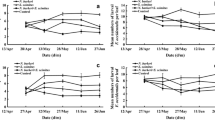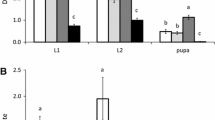Abstract
In a three-year study, mite populations were monitored in two vineyards, each having two grape varieties with different leaf hair density. In both vineyards native phytoseiids were present: Amblyseius andersoni in one vineyard, and Phytoseius finitimus in the other. The economically important predators Kampimodromus aberrans and Typhlodromus pyri were released in both vineyards in order to study their efficacy in controlling tetranychids and eriophyids and their persistence during periods of prey scarcity. In both vineyards, relative abundances of the mite species, especially phytoseiids, were found to differ on different varieties in the same vineyard. In the first experiment, A. andersoni reached higher densities and was more persistent on the variety with slightly pubescent leaf under-surface (Merlot). Typhlodromus pyri and K. aberrans releases were successful and the mites became more abundant on the variety with pubescent leaf under-surface (Verduzzo). In the second experiment, P. finitimus was more abundant on a variety with pubescent leaf under-surface (Prosecco) than with glabrous leaf under-surface (Riesling). The most interesting results of the present study concerned the interactions between native and released predators. In the first vineyard, different results were obtained when releasing T. pyri on the two varieties. On the variety with pubescent leaves, A. andersoni was rapidly displaced by T. pyri, whereas the former species persisted on the other variety throughout the three-year study, apparently becoming dominant during the last season. In contrast to T. pyri, interactions between K. aberrans and A. andersoni in this vineyard did not depend on variety. The results of the experiments carried out in the second vineyard stressed the importance of interspecific competition for phytoseiid releases. Typhlodromus pyri colonization failed on both varieties. Kampimodromus aberrans releases appeared to be more successful on Riesling than on Prosecco, where P. finitimus was more abundant. At the end of the experiments, K. aberrans displaced P. finitimus on both varieties.
Similar content being viewed by others
References
Camporese, P. and Duso, C. 1996. Different colonisation patterns of phytophagous and predatory mites (Acari: Tetranychidae, Phytoseiidae) on three grape varieties: a case study. Exp. Appl. Acarol. 20, 1–22.
Castagnoli, M. and Liguori, M. 1985. Prime osservazioni sul comportamento di Kampimodromus aberrans (Oud.), Typhlodromus exhilaratus Ragusa e Phytoseius plumifer (Can. e Fanz.) (Acarina: Phytoseiidae) sulla vite in Toscana. Redia 68, 323–337.
Chant, D.A. 1958. Immature and adult stages of some British Phytoseiidae Berl., 1916 (Acari). J. Linn. Soc. London 43, 599–643.
Chant, D.A. 1959. Phytoseiid mites (Acarina: Phytoseiidae). Part I. Bionomics of seven species in southeastern England. Part II. A taxonomic review of the family Phytoseiidae, with descriptions of thirty-eight new species. Can. Ent. 91(supp.), 166 pp.
Croft, B.A. and Croft, M.B. 1993. Larval survival and feeding by immature Metaseiulus occidentalis, Neoseiulus fallacis, Amblyseius andersoni and Typhlodromus pyri on life stage groups of Tetranychus urticae Koch and phytoseiid larvae. Exp. Appl. Acarol. 17, 685–693.
Croft, B.A. and Croft, M.B. 1996. Intra-and interspecific predation among adult female phytoseiid mites (Acari: Phytoseiidae): effects on survival and reproduction. Environ. Entomol. 25, 853–858.
Croft, B.A. and McRae, I.V. 1992a. Biological control of apple mites by mixed populations of Typhlodromus pyri and Metaseiulus occidentalis (Acari: Phytoseiidae). Environ. Entomol. 21, 202–209.
Croft, B.A. and McRae, I.V. 1992b. Persistence of Typhlodromus pyri and Metaseiulus occidentalis (Acari: Phytoseiidae) on apple after inoculative release and competition with Zetzellia mali (Acari: Stigmaeidae). Environ. Entomol. 21, 1168–1177.
Croft, B.A. and McRae, I.V. 1993. Biological control of apple mites: impact of Zetzellia mali (Acari: Stigmaeidae) on Typhlodromus pyri Scheuten and Metaseiulus occidentalis (Nesbitt) (Acari: Phytoseiidae). Environ. Entomol. 22, 865–873.
Croft, B.A., Kim, S.S. and Kim, D.I. 1996. Intra-and interspecific predation on four life stage groups by the adult females of Metaseiulus occidentalis, Typhlodromus pyri, Neoseiulus fallacis and Amblyseius andersoni (Acari: Phytoseiidae). Exp. Appl. Acarol. 20, 435–444.
Duso, C. 1989. Role of the predatory mites Amblyseius aberrans (Oud.), Typhlodromus pyri Scheuten and Amblyseius andersoni (Chant) (Acari, Phytoseiidae) in vineyards. I. The effects of single or mixed phytoseiid population releases on spider mite densities (Acari, Tetranychidae). J. Appl. Entomol. 107, 474–492.
Duso, C. 1992. Role of the predatory mites Amblyseius aberrans (Oud.), Typhlodromus pyri Scheuten and Amblyseius andersoni (Chant) (Acari, Phytoseiidae) in vineyards. III. Influence of variety characteristics on the success of A. aberrans and T. pyri releases. J. Appl. Entomol. 114, 455–462.
Duso, C. and Camporese, P. 1991. Developmental times and oviposition rates of predatory mites Typhlodromus pyri and Amblyseius andersoni (Acari: Phytoseiidae) reared on different foods. Exp. Appl. Acarol. 13, 117–128.
Duso, C. and Pasqualetto, C. 1993. Factors affecting the potential of phytoseiid mites (Acari: Phytoseiidae) as biocontrol agents in North-Italian vineyards. Exp. Appl. Acarol. 17, 241–258.
Duso, C. and Moretto, S. 1994. Osservazioni preliminari sul comportamento dell'acaro predatore Phytoseius plumifer (Can. & Fanz.) (Acari Phytoseiidae). Mem. Soc. Entom. Ital. 72, 533–540.
Duso, C. and Ren, L. 1997. Ulteriori indagini sull'acarofauna della vite nel Veneto: l'area collinare trevigiana. Riv. Vitic. Enol. Conegliano 50, 11–28.
Duso, C., Pasqualetto, C. and Camporese, P. 1991. Role of the predatory mites Amblyseius aberrans (Oud.), Typhlodromus pyri Scheuten and Amblyseius andersoni (Chant) (Acari, Phytoseiidae) in vineyards. II. Minimum releases of A. aberrans and T. pyri to control spider mite populations (Acari, Tetranychidae). J. Appl. Entomol. 112, 298–308.
Duso, C., Malagnini, V., Paganelli, A. 1997. Indagini preliminari sul rapporto tra polline e Kampimodromus aberrans (Oudemans) (Acari: Phytoseiidae) su Vitis vinifera L. Allionia 35, 229–239.
Girolami, V., Coiutti, C. and Picotti, P. 1992. Ruolo determinante del fitoseide Amblyseius aberrans (Oud.) nel controllo degli acari fitofagi. L'informatore agrario 48, 65–69.
McMurtry, J.A., Huffaker, C.B. and Van de Vrie, M. 1970. Ecology of tetranychid mites and their natural enemies: a review. 1. Tetranychid enemies, their biological characteristics and the impact of spray practices. Hilgardia 40, 331–390.
MacRae, I.V. and Croft, B.A. 1993. Influence of temperature on interspecific predation and cannibalism by Metaseiulus occidentalis and Typhlodromus pyri (Acarina: Phytoseiidae). Environ. Entomol. 22, 770–775.
MacRae, I.V. and Croft, B.A. 1996. Differential impact of egg predation by Zetzellia mali (Acari: Stigmaeidae) on Metaseiulus occidentalis and Typhlodromus pyri (Acarina: Phytoseiidae). Exp. Appl. Acarol. 20, 143–154.
Rasmy, A.H. and El-Banhawy, E.M. 1974. Behaviour and bionomics of the predator mite Phytoseius plumifer (Acarina: Phytoseiidae) as affected by physical surface features of host plants. Entomophaga 19, 255–257.
Rosenheim, J.A., Kaya, H.K., Ehler, L.E., Marois, J.J. and Jaffee, B.A. 1995. Intraguild predation among biological-control agents: theory and evidence. Biological control 5, 303–335.
SAS Institute Inc. 1989. SAS/STAT User's Guide (Release 6.11). SAS Institute Inc., Cary, NC.
Strapazzon, A. and Dalla Montà, L. 1988. Ruolo e distribuzione di Amblyseius andersoni (Chant) e di Zetzellia mali (Ewing) in meleti infestati da Aculus schlechtendali (Nal.). Redia 71, 39–54.
Tixier, M.S., Kreiter, S., Auger, Ph. and Weber, M. 1998. Colonisation of Languedoc vineyards by phytoseiid mites (Acari: Phytoseiidae): influence of wind and crop environment. Exp. Appl. Acarol. 22, 523–542.
Walde, S.J., Hardmann, J.M. and Magagula, C.N. 1997. Direct and indirect species interactions influencing within-season dynamics of apple rust mite, Aculus schlechtendali (Acari: Eriophyidae). Exp. Appl. Acarol. 21, 587–614.
Yao, D.S. and Chant, D.A. 1989. Population growth and predation interference between two species of predatory phytoseiid mites (Acarina: Phytoseiidae) in interactive systems. Oecologia 80, 443–455.
Zhang, Z.-Q. and Croft, B.A. 1994. A comparative life history study of immature Amblyseius fallacis, Amblyseius andersoni, Typhlodromus occidentalis and Typhlodromus pyri (Acari: Phytoseiidae) with a review of larval feeding patterns in the family. Exp. Appl. Acarol. 18, 631–657.
Zhang, Z.-Q. and Croft, B.A. 1995. Interspecific competition and predation between immature Amblyseius fallacis, Amblyseius andersoni, Typhlodromus occidentalis and Typhlodromus pyri (Acari: Phytoseiidae). Exp. Appl. Acarol. 19, 247–257.
Rights and permissions
About this article
Cite this article
Duso, C., Vettorazzo, E. Mite Population Dynamics on Different Grape Varieties With or Without Phytoseiids Released (Acari: Phytoseiidae). Exp Appl Acarol 23, 741–763 (1999). https://doi.org/10.1023/A:1006297225577
Issue Date:
DOI: https://doi.org/10.1023/A:1006297225577




